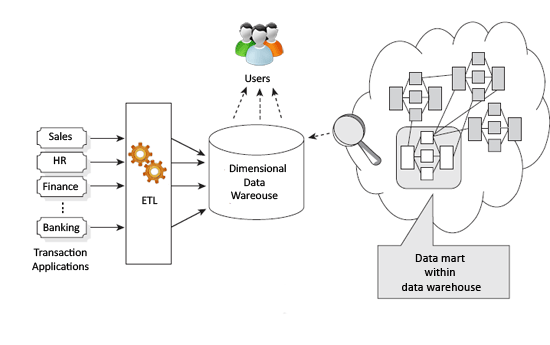Summary: in this article, we will discuss Ralph Kimball data warehouse architecture which is known as dimensional data warehouse architecture.
Introduction to Ralph Kimball data warehouses architecture
Let’s start with Ralph Kimball data warehouse by looking into the picture below from left to right.

We will examine the elements of Ralph Kimball data warehouse architecture in detail:
- Transaction applications are the operational systems created to capture business transactions. The data of the transaction system usually stored in relational databases or even flat files such as a spreadsheet. Those transaction systems are source systems of the data warehouse in Ralph Kimball’s data warehouse architecture.
- ETL. To bring data from the transaction system in various forms, the ETL processes are used. ETL stands for extract, transform, and load. The data in different formats are standardized and converted into a format that ready to load into the data warehouse.
- A dimensional data warehouse is the heart of data warehouse architecture. The dimensional data warehouse contains enterprise data in high granular format. While Bill Inmon’s data warehouse architecture using ER modeling, the dimensional data warehouse is designed using dimensional modeling. It means a dimensional data warehouse consists of a star schema or cubes. The analytic systems or reporting tools can access data from dimensional data warehouses directly.
- Datamart. In this architecture, the data mart concept is just a logical distinction. The data mart is a subject area within the dimensional data warehouse.
The dimensional data warehouse architecture is also known as the enterprise data warehouse, bus architecture, architected data marts, or virtual data marts.

In this article, we’ve discussed Ralph Kimball data warehouse architecture called the dimensional data warehouse. In dimensional data warehouse architecture, data is organized dimensionally in series of star schemas or cubes using dimensional modeling. A data mart is a logical concept, that contains subject area data within the dimensional data warehouse. A dimensional data warehouse is directly accessible by analytic systems.